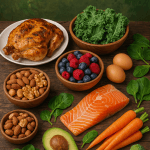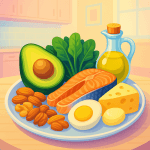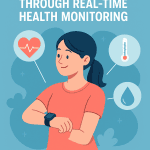With heart disease and high blood pressure affecting millions globally, there has never been a greater need for a dietary approach that is both effective and sustainable. Enter the DASH Diet—a nutritional strategy developed specifically to lower blood pressure and improve cardiovascular health, but with benefits that extend far beyond the heart.
Standing for Dietary Approaches to Stop Hypertension, the DASH diet is backed by decades of rigorous scientific research and is consistently ranked among the top healthiest diets in the world. But unlike restrictive or fad-based plans, the DASH diet thrives on balance. It emphasizes nutrient-rich, real foods—not elimination, extremes, or gimmicks.
This guide will take you deep into the world of DASH: how it works, what makes it so effective, who can benefit from it, what to eat, and how to adopt it as a long-term lifestyle. Whether you’re managing high blood pressure, aiming for overall wellness, or simply looking for a smarter way to nourish your body, the DASH diet is a proven, practical, and powerful solution.
What Is the DASH Diet?
The DASH diet was developed by the National Institutes of Health (NIH) through its National Heart, Lung, and Blood Institute (NHLBI). It was designed to prevent and lower hypertension (high blood pressure) without the need for medication.
Its principles center around:
- Reducing sodium intake
- Increasing consumption of foods rich in potassium, calcium, and magnesium
- Focusing on fruits, vegetables, whole grains, lean protein, and low-fat dairy
- Limiting saturated fat, red meat, sweets, and sugary beverages
Unlike trend-driven diets, DASH is flexible and inclusive, encouraging people to eat a variety of nutrient-dense foods that are readily available in most grocery stores.
How the DASH Diet Lowers Blood Pressure
Blood pressure is affected by the balance of fluids and electrolytes in the body—especially sodium, potassium, calcium, and magnesium. The DASH diet works by adjusting that balance through smart food choices.
It also helps reduce:
- Arterial stiffness
- Blood vessel inflammation
- Cholesterol and triglyceride levels
When followed consistently, studies show that the DASH diet can lower systolic blood pressure by 8–14 mmHg—comparable to the effects of some medications.
Key Nutritional Features of the DASH Diet
The standard DASH diet recommends:
- 6–8 servings of grains (with an emphasis on whole grains)
- 4–5 servings of vegetables
- 4–5 servings of fruits
- 2–3 servings of low-fat dairy
- 2 or fewer servings of lean meat, poultry, or fish
- 4–5 servings of nuts, seeds, and legumes per week
- 2 or fewer servings of sweets per week
- Daily sodium intake between 1,500–2,300 mg, depending on individual health status
This nutrient-rich, fiber-dense approach naturally leads to better satiety, improved digestion, and stable energy levels, making it easier to maintain healthy habits long term.
Top Benefits of the DASH Diet
Heart Health
The DASH diet is designed to protect and improve cardiovascular health. It helps by:
- Lowering high blood pressure
- Improving cholesterol profiles
- Reducing the risk of heart attack and stroke
It’s particularly beneficial for those with hypertension, prehypertension, or a family history of heart disease.
Weight Management
Although it wasn’t created as a weight-loss diet, the DASH plan naturally encourages calorie control and healthier eating patterns. Most people experience gradual, sustainable weight loss by replacing high-calorie, nutrient-poor foods with fiber- and protein-rich alternatives.
Type 2 Diabetes Support
The DASH diet emphasizes complex carbs, lean proteins, and healthy fats, which help regulate blood sugar and improve insulin sensitivity. It’s often recommended for people with type 2 diabetes or metabolic syndrome.
Kidney Function
By reducing sodium and emphasizing hydration and potassium-rich foods, DASH can help protect the kidneys, especially in individuals with early-stage kidney disease or high blood pressure.
Reduced Cancer Risk
A high intake of vegetables, fruits, and fiber-rich foods has been associated with a lower risk of colorectal, breast, and other cancers. DASH’s emphasis on antioxidant-rich foods supports this protection.
Bone Health
Thanks to its focus on calcium and magnesium, particularly from low-fat dairy and leafy greens, DASH supports strong bones and reduces the risk of osteoporosis.
What to Eat on the DASH Diet
Fruits and Vegetables
These should form the cornerstone of every meal. They’re rich in fiber, potassium, antioxidants, and water content, which all contribute to blood pressure regulation and satiety.
Examples include:
- Leafy greens, carrots, bell peppers, tomatoes
- Berries, oranges, bananas, apples, grapes
Whole Grains
Whole grains provide complex carbohydrates and essential nutrients that help sustain energy and improve digestion.
Include:
- Oats, quinoa, brown rice, whole wheat bread or pasta, barley
Lean Protein
Protein keeps you full and supports muscle and tissue health. DASH focuses on lean, heart-healthy sources.
Try:
- Skinless poultry, fish, tofu, eggs, beans, lentils
Low-Fat Dairy
Dairy is a primary source of calcium and vitamin D. Choose unsweetened, low-fat varieties.
Great options:
- Greek yogurt, cottage cheese, skim or 1% milk
Nuts, Seeds, and Legumes
Packed with fiber, plant protein, and healthy fats, these foods contribute to satiety and metabolic health.
Add:
- Almonds, walnuts, flaxseeds, chickpeas, black beans
Healthy Fats
The DASH diet includes small amounts of healthy fats from plant-based sources.
Go for:
- Olive oil, avocado, nuts, and seeds
What to Limit or Avoid
- Sodium: Aim for no more than 2,300 mg/day—or 1,500 mg/day if managing high blood pressure.
- Red and processed meats: These are high in saturated fat and sodium.
- Sugary beverages and snacks: Avoid sodas, sweetened juices, and highly processed desserts.
- Full-fat dairy and fried foods: These can contribute to weight gain and poor heart health.
- Alcohol: Limit intake to no more than one drink per day for women and two for men.
Sample One-Day DASH Diet Meal Plan
Breakfast
Oatmeal with sliced banana and a tablespoon of chopped walnuts
Low-fat milk
Green tea or black coffee
Mid-Morning Snack
Greek yogurt with a handful of blueberries
Lunch
Grilled chicken breast
Quinoa salad with cherry tomatoes, cucumber, and olive oil
Steamed broccoli
Water with lemon
Afternoon Snack
Sliced apple with natural almond butter
Dinner
Baked salmon with lemon and dill
Brown rice pilaf
Steamed green beans and carrots
Sparkling water
Dessert
A small square of dark chocolate or fresh fruit bowl
Making the DASH Diet Work for You
Start Small
You don’t have to overhaul your entire diet overnight. Begin with one meal per day or focus on adding more fruits and vegetables to your plate.
Cook at Home More Often
Restaurant and packaged meals often contain hidden sodium. Home cooking gives you full control over ingredients and portion sizes.
Read Nutrition Labels
Learn to spot sodium, added sugars, and saturated fats in packaged goods. Aim for items with less than 140 mg of sodium per serving.
Meal Prep for Success
Plan your meals for the week, prep ingredients in batches, and stock your pantry with DASH-friendly staples.
Track Your Progress
Use a food journal or app to stay mindful of your sodium intake, servings of fruits and veggies, and hydration levels.
Don’t Forget Movement
While the DASH diet focuses on food, it works best when combined with regular physical activity. Aim for at least 30 minutes of moderate exercise most days.
DASH vs. Mediterranean Diet: What’s the Difference?
Both are highly ranked, heart-healthy diets, but they differ slightly:
DASH Diet
Focus: Lowering blood pressure
Emphasizes: Sodium reduction, low-fat dairy, structured portions
Less focus on fat intake
Mediterranean Diet
Focus: General wellness and longevity
Emphasizes: Healthy fats (especially olive oil), seafood, red wine in moderation
More relaxed, culturally rooted
You can combine elements of both for a powerful and enjoyable nutrition strategy.
Who Should Consider the DASH Diet?
- People with high blood pressure or prehypertension
- Those with a family history of cardiovascular disease
- Individuals seeking a sustainable, non-restrictive eating plan
- People with type 2 diabetes or insulin resistance
- Anyone looking to lose weight while improving overall nutrition
The DASH diet is suitable for adults, seniors, and even children, with slight modifications to accommodate individual needs.
FAQs
Yes. While it’s not specifically designed for weight loss, many people shed excess pounds naturally due to reduced sodium, sugar, and calorie-dense foods.
Absolutely. Simply replace animal proteins with legumes, tofu, nuts, and plant-based dairy alternatives.
Not necessarily. The DASH plan focuses more on serving sizes and food groups. However, mindful calorie tracking may help with weight management.
The 1,500 mg level is recommended for people who need more aggressive blood pressure management, while 2,300 mg is considered a general upper limit.
Many people notice a drop in blood pressure within two weeks of following the DASH plan consistently.
Yes. DASH helps lower LDL cholesterol and triglycerides, especially when combined with physical activity and reduced saturated fat intake.








Post a comment